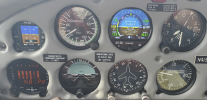rickgn
Pre-Flight
Hi all,
I have about 1300 hours and I've been flying for 18 years. I decided to get my commercial done this year. Has anyone done a checkride in a high performance 300 HP airplane? If so, did you find it difficult, or would you say the difficulty level is probably the same if I already know the airplane?
Will it make it harder to do chandelles and lazy 8's having a lot of HP up front? Or is it just a matter of adjusting speed?
I have 77 Piper Lance 300 HP. Maneuvering speed is 115-125 knots (depending on weight). Best rate of climb is 96 kt. It climbs at 1400+ FPM. Stall speed is around 60 knots with the flaps up. So basically everything is 15-20 knots faster than a trainer and it takes a lot of altitude to get it to a stall speed. Last time I tried a power on stall I think I was 25+ degrees nose up before it finally stopped climbing, and it didn't really nose over. I had to use a lot of trim to get it to pitch that high.
Does the checkride allow for doing the maneuvers at lower initial power settings? I'm assuming it would, because I'd need to be at about 20" MP to get to maneuvering speed.
The alternative is to rent something with lower power that is simple to handle.
Thoughts? Advice? Thanks.
I have about 1300 hours and I've been flying for 18 years. I decided to get my commercial done this year. Has anyone done a checkride in a high performance 300 HP airplane? If so, did you find it difficult, or would you say the difficulty level is probably the same if I already know the airplane?
Will it make it harder to do chandelles and lazy 8's having a lot of HP up front? Or is it just a matter of adjusting speed?
I have 77 Piper Lance 300 HP. Maneuvering speed is 115-125 knots (depending on weight). Best rate of climb is 96 kt. It climbs at 1400+ FPM. Stall speed is around 60 knots with the flaps up. So basically everything is 15-20 knots faster than a trainer and it takes a lot of altitude to get it to a stall speed. Last time I tried a power on stall I think I was 25+ degrees nose up before it finally stopped climbing, and it didn't really nose over. I had to use a lot of trim to get it to pitch that high.
Does the checkride allow for doing the maneuvers at lower initial power settings? I'm assuming it would, because I'd need to be at about 20" MP to get to maneuvering speed.
The alternative is to rent something with lower power that is simple to handle.
Thoughts? Advice? Thanks.


